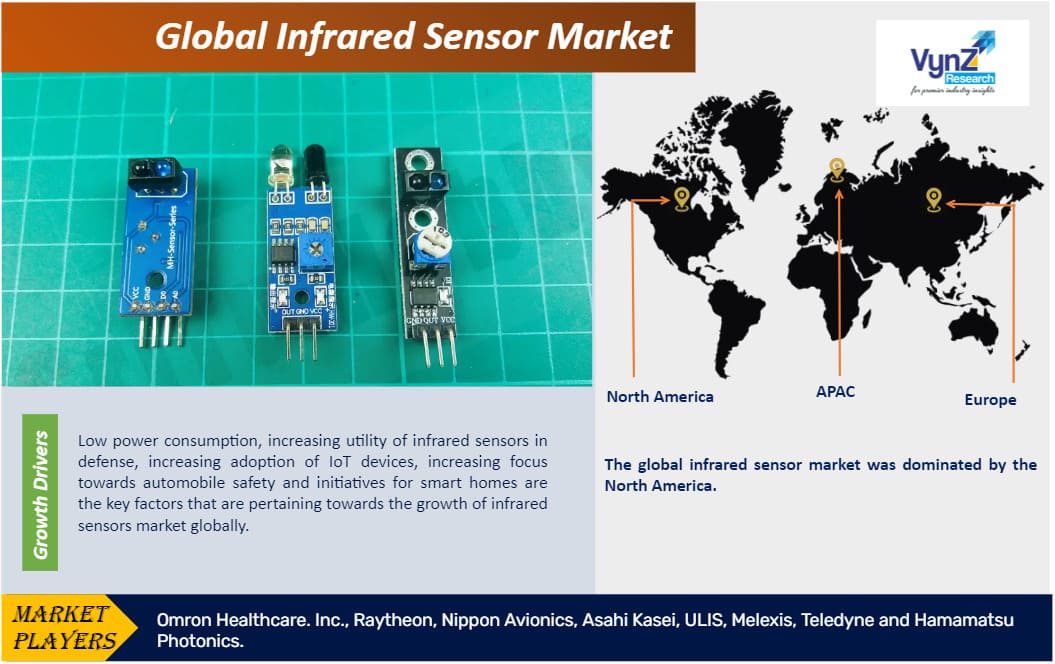Industry Overview
Infrared Sensor is an electrically powered instrument that senses the characteristics of the surroundings that is done by detecting infrared radiation. This technology is also capable of measuring heat being emitted from a motion or an object. The advantage of the infrared sensors is lower power requirements and easy portability that is further helping infrared market to obtain significant growth in the near future.

Infrared Sensor Market Segmentation
Insight by Detection Technology
There are two types of detection technology in infrared sensors market that include cooled and uncooled sensors. Among these segments, uncooled infrared sensors are expected to generate the largest revenue during forecast period since it helps the system in identifying errors and detecting size, cost, power, and weight as per the requirement of various industries in their business operations. Furthermore, uncooled infrared sensors are used for formulating linear array that is suitable for spacecraft and commercial applications. Moreover, extensive growth of this segment is further strengthening the growth of infrared sensor market across the globe.
Insight by Working Mechanism
Based upon the working mechanism the infrared sensor market across the globe is categorized into thermopile IR, photo interrupter, quantum, IR emitters, passive IR and others. Among these segments, passive IR is anticipated to witness the fastest growth during the forecast period. Passive IR systems are also known as an occupancy sensor and sense infrared signal that is emitted from a human body or various other objects it is extremely beneficial in detecting motion in indoors or day or dark time. Increasing application of passive IR incompact and small premises is further driving the growth of infrared sensor market globally at an extensive rate.
Insight by End-User
Based on end-users, the infrared sensor market is categorised into aerospace & defence, manufacturing, oil & gas, chemical, consumer electronics, healthcare, mining, telecommunications and automotive. Among all these segments, consumer electronics is anticipated to generate the largest revenue by 2030. Infrared sensors are considered to be the cost-effective option and help users attain excessive energy efficiencies. These sensors are extensively being deployed in portable devices such as smartphones, tablets and laptops.
It is also used in various gaming applications that sense the movement of the user and further translate it on the screen. Furthermore, the extensive utilization of infrared sensors for navigation purposes and home appliances is further bolstering the growth of infrared sensor market globally.
Global Infrared Sensor Market Report Coverage
|
Report Metric
|
Details
|
|
Historical Period
|
2018 - 2023
|
|
Base Year Considered
|
2024
|
|
Forecast Period
|
2025 - 2030
|
|
Market Size in 2024
|
U.S.D. XX Billion
|
|
Revenue Forecast in 2030
|
U.S.D. XX Billion
|
|
Growth Rate
|
XX%
|
|
Segments Covered in the Report
|
By Detection Technology, By Working Mechanism, and By End-User
|
|
Report Scope
|
Market Trends, Drivers, and Restraints; Revenue Estimation and Forecast; Segmentation Analysis; Impact of COVID-19; Companies’ Strategic Developments; Market Share Analysis of Key Players; Company Profiling
|
|
Regions Covered in the Report
|
North America, Europe, Asia-Pacific, Middle East, and Rest of the World
|
Industry Dynamics
Infrared Sensor Market Growth Drivers
Low power consumption, increasing utility of infrared sensors in defense, increasing adoption of IoT devices, increasing focus towards automobile safety and initiatives for smart homes are the key factors that are pertaining towards the growth of infrared sensors market globally. Low power consumption makes the technology more economical leading to more popularity among possible consumers. Furthermore, increasing initiatives for the safety of passengers in the automobile industry and its utility on defense significantly contributes towards the growth of infrared sensors market at an extensive rate.
Infrared Sensor Market Challenges
High manufacturing expenditure and maintenance costs are the major factors that are hampering the growth of the infrared sensor market globally. High costs make it difficult to be sold at reasonable prices, further, the maintenance costs are even higher, which makes the sensors difficult to afford.
Recent Developments by the Key Players
Raytheon (an RTX business) has awarded an USD 946 million contract to supply Romania with additional Patriot air and missile defense systems. The contract includes fire units consisting of control stations and radars.
Asahi Kasei Corporation and Honda Motor Co.Ltd. has collaborated for the production of lithium-ion battery separators in Canada.
Infrared Sensor Industry Ecosystem
Globally industry players are leveraging market growth through the development of innovative solutions and extensive research and development activities to drive the growth of the infrared sensor market across the globe. Furthermore, the vendors for infrared sensor technology are providing various solutions to users such as advanced technology for better delivery of sensation and ensuring improved quality to the users.
Infrared Sensor Market Geographic Overview
Geographically, infrared sensor market in North America is expected to generate the largest revenue by 2024 due to advanced initiatives were taken by the government towards the security concerns in an aspect of defense as well as automobile segments. Moreover, the presence of large players of the infrared sensor in this region is further revamping the growth of infrared sensor market in this region.
Moreover, infrared sensor market in Asia-Pacific is anticipated to witness the fastest growth during the forecast period because of the increasing developments in security standards and the increasing adoption of IoT in this region along with the presence of heavy manufacturing industries that are driving the growth of Infrared Sensor Market in this region.
Infrared Sensor Market Competitive Insight
Key players in the infrared sensor system market are launching new products in order to gain a competitive edge in the market and entering into mergers & acquisitions in order to improve their existing provider and penetrate deep into the global market.
- Omron Healthcare. Inc.
- Raytheon
- Nippon Avionics
- Asahi Kasei
- ULIS Melexis
- Teledyne
- Hamamatsu Photonics
.png)



.png)